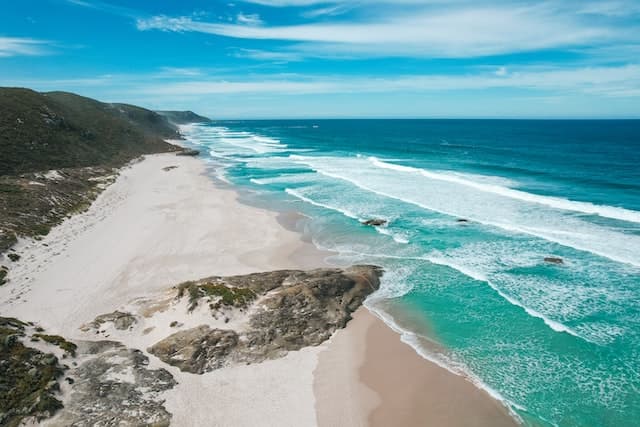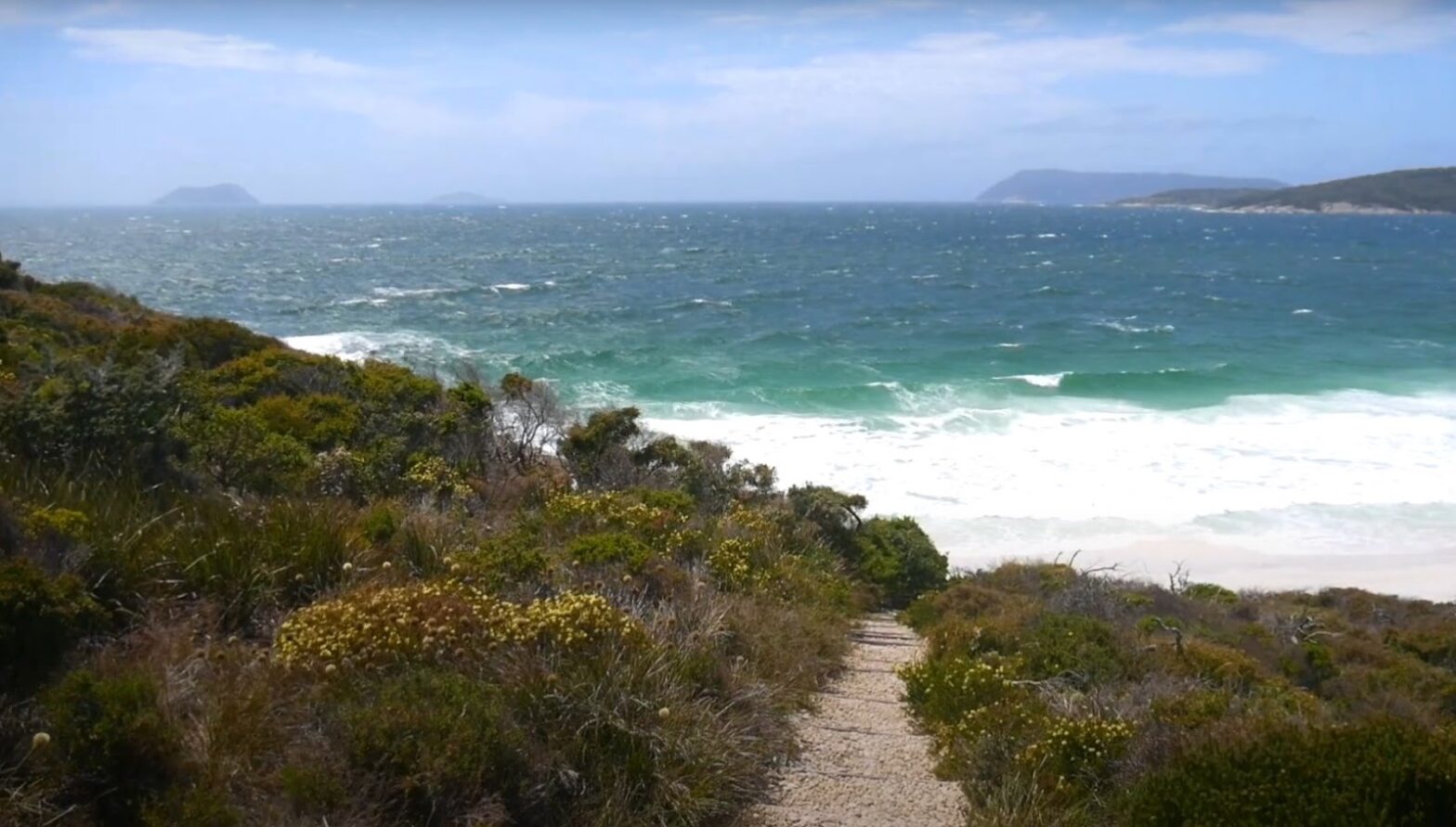Elephant Rocks, a spectacular natural wonder in Denmark, Western Australia, offers an unforgettable visual experience. These immense, oval boulders, characterized by their cracked surfaces, bear a striking resemblance to a herd of elephants meandering in the shallow waters of the Great Southern Ocean. This unique geological formation, set against the pristine backdrop of the ocean, provides a serene and picturesque setting for visitors. The sight of these giant rocks, gazing out upon the vast ocean, creates a sense of awe and wonder, making Elephant Rocks a must-visit destination for nature enthusiasts and photographers alike.
Accessing Elephant Rocks: A Guide
Reaching Elephant Rocks involves a scenic ten-minute walk from the Greens Pool car park, following a well-maintained track that meanders over gentle rises. This path offers an enjoyable trek through the natural landscape, allowing visitors to soak in the area’s serene beauty. For those seeking closer access, an alternative parking area is available, reached by taking a left and then the first right after entering the William Bay Area. This approach provides a shorter route to the rocks, making it a convenient option for those with limited time or mobility.
Parking Options at Elephant Rocks
Elephant Rocks features two accessible car parks, each offering different vantage points and convenience to visitors. The Greens Pool car park is suitable for those preferring a longer scenic walk, and another car park closer to Elephant Rocks, is ideal for direct access. Each parking area is equipped with staircases leading to the respective locations, and visitors are advised to note their chosen staircase for ease of return. These parking facilities are designed to accommodate a range of visitors, from casual tourists to avid hikers, ensuring a seamless experience for all.
Safety Guidelines for Visitors
Visiting Elephant Rocks requires adherence to safety guidelines, especially considering the cooler temperatures of the Great Southern Ocean. Snorkelers are advised to wear wetsuits for protection against the colder waters. Extreme caution is paramount near the ocean, particularly for families with children. Visitors are strongly discouraged from climbing over the rocks to prevent accidents. These safety measures ensure a secure and enjoyable visit for everyone, allowing them to fully appreciate the beauty of Elephant Rocks without undue risk.
The Journey to Elephant Rocks
The journey to Elephant Rocks is as captivating as the destination itself. Situated within William Bay National Park, the hike to these formations is a delightful experience through Western Australia’s unique landscapes. The park map clearly marks the path to Elephant Rocks, guiding hikers through an enriching outdoor adventure. The trail is surrounded by native flora and fauna, offering glimpses of the region’s biodiversity and providing numerous opportunities for wildlife observation and photography.
Exploring Elephant Cove
Descending from Elephant Rocks, visitors are led to the serene Elephant Cove, accessible via a staircase nestled snugly between the rocks. This descent ends at a beach crevasse, revealing a hidden sandy beach ensconced within the cove. The unique positioning of Elephant Cove, just east of the rocks, offers a tranquil and somewhat secluded spot for visitors to relax and immerse themselves in the natural beauty of the area. The cove’s peaceful ambiance is enhanced by the towering boulders that encircle it, creating a feeling of being in a world apart.
Unique Features of Elephant Rocks
Elephant Rocks stands out for its unique features that create a magical and surreal landscape. The formation resembles a herd of elephants, an intriguing natural phenomenon that sparks the imagination. The rocks’ immense size, coupled with their distinctive shape and texture, make them a photographer’s dream. The way these boulders are positioned, seemingly gazing out into the ocean, adds to their mystique, making Elephant Rocks an iconic landmark in the region.
Precautions and Swimming Safety
While the nearby Greens Pool offers a more sheltered swimming environment, Elephant Cove presents certain challenges. Visitors are urged to exercise caution due to larger waves and potential rips. For a safer swimming experience, a short westward walk leads to Greens Pool, known for its calmer waters. Awareness of tide conditions and ocean surges is crucial when visiting Elephant Cove, ensuring a safe and enjoyable experience for all.
Navigating to Elephant Rocks
Elephant Rocks is easily navigable, with clear signage from the car park guiding visitors to this natural wonder. As one ventures east of Greens Pool, additional signs point the way, making it simple for visitors to find their way to the rocks. This well-signposted path ensures that all visitors, regardless of their familiarity with the area, can access Elephant Rocks with ease.
Elephant Rocks and Greens Pool: A Comparative Analysis
| Feature | Elephant Rocks | Greens Pool |
|---|---|---|
| Landscape | Giant boulder formations | Sheltered swimming area |
| Access | Scenic hike from car park | Direct access from car park |
| Swimming Conditions | Larger waves, potential rips | Calmer waters, safer swimming |
| Unique Aspect | Resembles a herd of elephants | Natural rock pool formation |
| Safety | Caution advised near water | Generally safer for swimming |
| Visitor Experience | Mystical, serene environment | Family-friendly, relaxed atmosphere |
| Photography | Dramatic landscape shots | Idyllic swimming and beach photos |
Key Highlights of Elephant Rocks
- Resembles a herd of elephants;
- Part of William Bay National Park;
- Accessible via a scenic hike or closer parking area;
- Features Elephant Cove with a beach crevasse;
- Important safety guidelines due to ocean conditions;
- Ideal for nature enthusiasts and photographers;
- Close proximity to Greens Pool for safer swimming.
Tree Top Walk Albany: An Aerial Adventure in Nature
In contrast to the ocean-level experience at Elephant Rocks, the Tree Top Walk in Albany offers an entirely different perspective of Western Australia’s natural beauty. Located within the Valley of the Giants in the Walpole-Nornalup National Park, this remarkable walkway, elevated 40 meters above the ground, provides visitors with a unique opportunity to explore the forest canopy.
Highlights of the Tree Top Walk:
- Elevated Walkway: The Tree Top Walk features a 600-meter-long steel-trussed walkway, suspended high above the ground, allowing visitors to wander amongst the treetops;
- Accessibility: This walkway is fully accessible, accommodating visitors with diverse mobility needs, including those in wheelchairs and strollers;
- Flora and Fauna: The walkway provides a unique vantage point to observe the diverse flora and fauna of the region’s ancient tingle forest;
- Educational Experience: The Tree Top Walk is not only a recreational journey but also an educational experience, offering insights into the forest’s ecosystem and conservation efforts;
- Connection to Nature: This aerial walk offers a serene and immersive nature experience, contrasting the beachside setting of Elephant Rocks with the tranquility of the forest.
The Tree Top Walk in Albany complements the coastal experience of Elephant Rocks, providing visitors with a comprehensive understanding of the region’s diverse natural landscapes.
Conclusion
Elephant Rocks in Albany is a testament to the awe-inspiring power and beauty of nature. These magnificent rock formations, resembling elephants, create a unique and captivating landscape that draws visitors from all over. Coupled with the tranquil Elephant Cove and the nearby Greens Pool, Elephant Rocks offers a comprehensive experience of the region’s natural beauty. Whether for hiking, photography, or simply enjoying the serene environment, Elephant Rocks stands as a must-visit destination on Western Australia’s southern coast.



